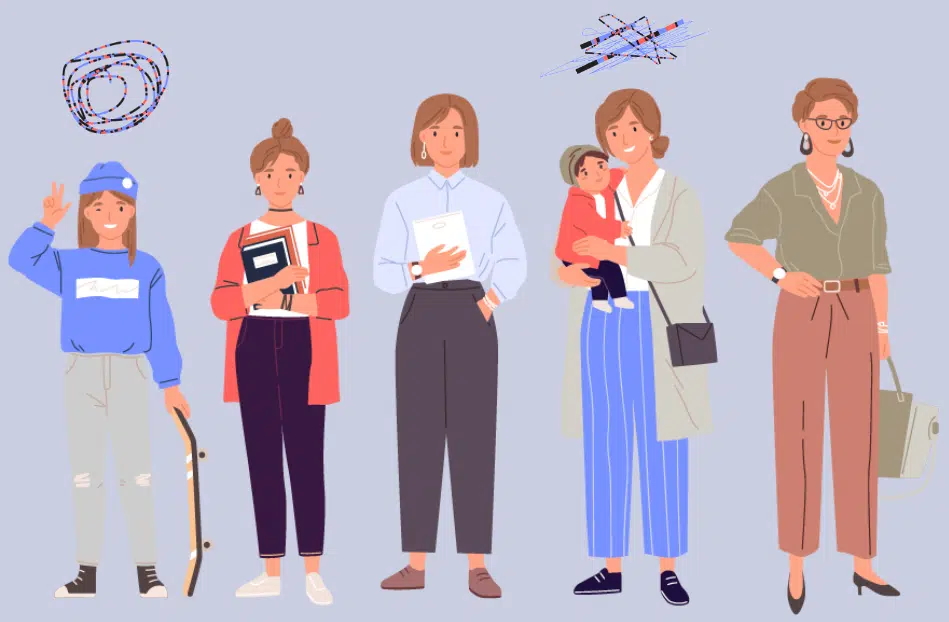Attention deficit hyperactivity disorder, or ADHD, is often underdiagnosed or misdiagnosed in women because its symptoms tend to present differently than in men. The overall prevalence of adult ADHD is 4.4%, and in that, the prevalence was higher in males at 5.4% than in females at 3.2%.
While ADHD is commonly associated with hyperactivity and impulsiveness, women with ADHD are more likely to exhibit more inattentive symptoms and fewer hyperactive or impulsive behaviors compared to boys with the condition. These symptoms can manifest in ways that are less overt, leading to the misconception that women are simply “daydreamers” or “unfocused.”
Let’s delve deeper to gain a better understanding of ADHD in women.

ADHD in Women: Gender Gap Diagnosis
Women with ADHD often go undiagnosed until adulthood, while men receive earlier identification and treatment. This diagnostic gap leaves many females struggling with untreated symptoms and being undiagnosed for years, as male-to-female ADHD diagnoses ranged from 2:1 to 10:1, with higher ratios found in clinical vs. general population-based samples.
This diagnosis gap stems largely from how ADHD symptoms manifest across genders. Females more commonly experience “inattentive symptoms”—short attention spans, organization struggles, and forgetfulness—rather than the hyperactive behaviors frequently observed in males, which are easier to notice. An example of this is Sarah Singh, a woman diagnosed with ADHD at thirty-eight who remembers her struggles as a child: “In school, I was the daydreamer staring out the window, not the kid bouncing off the walls. Teachers just said I needed to ‘apply myself more.’”
This manifestation of ADHD, which is more prevalent in women and is represented by inattention as opposed to hyperactivity, frequently goes undiagnosed.
ADHD Symptoms in Women
Women display different symptom profiles than men, which contributes to underdiagnosis. The consequences of misdiagnosis or remaining undiagnosed could result in years of self-esteem issues and feelings of inadequacy due to unexplained difficulties. Thus, women with ADHD often experience:
- Difficulty in time management and organization
- Internal restlessness
- Emotional dysregulation
- Hormonal fluctuations
Moreover, unlike the disruptive behaviors that often flag ADHD in men, women’s symptoms frequently appear in the context of daily functioning difficulties, interpersonal relationships, and body or self-regulation–areas that are not usually captured by traditional ADHD assessments developed from male presentation patterns.

When ADHD Meets Estrogen
There is an interesting link between female hormones and ADHD wherein when women have low estrogen levels, they also experience low dopamine, and ADHD symptoms are high. Low estrogen usually happens during the menstrual cycle or when a woman is experiencing menopause. Here are more information nuggets about the female hormones.
The Estrogen-Dopamine Relationship
As mentioned, dopamine is modulated by estrogen. This biochemical relationship creates a complex interplay that can intensify attention and function difficulties.
Life Stages and Symptom Intensity
“Dopamine is modulated by estrogen,” explains Tracy Otsuka, an author and ADHD expert. ADHD in women causes symptom fluctuations during major hormonal phases; these critical periods include puberty when hormones first surge, pregnancy and postpartum phases, when dramatic hormonal shifts occur, and perimenopause and menopause, when estrogen levels decline significantly.
Menstrual Cycle Effects
A woman’s menstrual cycle can also trigger ADHD symptom variations. Those experiencing Premenstrual Syndrome (PMS) or the more severe Premenstrual Dysphoric Disorder (PMDD) may find their ADHD symptoms particularly difficult to manage during certain phases of their cycle, requiring additional coping strategies and support.
These hormonal influences help women anticipate difficult periods and develop their own approaches to managing their ADHD symptoms throughout life and monthly cycles.
How Does ADHD Affect Women’s Lives?
Women who have ADHD experience more than attention and focus issues; it also creates ripple effects through every aspect of their daily routines. Understanding these helps illuminate why proper diagnosis and treatment are crucial for women’s overall well-being.
Professional and Social Struggles
The functioning difficulties associated with ADHD in women can manifest in missed deadlines, organizational struggles, and attention problems during meetings or conversations. These challenges may be misinterpreted by colleagues as carelessness or lack of commitment, leading to strained professional relationships.
Additionally, women with ADHD often struggle with remembering plans, maintaining a smooth conversation without jumping in or interrupting frequently, and regulating their emotions, especially when facing rejections or sudden changes. These difficulties can lead to social isolation and withdrawal, as women report feeling misunderstood or rejected by their peer groups.
Romance Difficulties
Women with ADHD experience difficulty in intimate relationships when it manifests as inconsistent communication, impulsive reactions during disagreements, or difficulty following through on shared responsibilities. The emotional dysregulation associated with ADHD can intensify relationship conflicts, as women may experience heightened emotional responses or difficulty articulating their feelings properly.
Negative Self-Perception
The most significant impact that ADHD has on women is their self-perception. Studies consistently show that women with undiagnosed ADHD develop significantly lower self-esteem and self-efficacy. Without understanding the neurobiological basis of their struggles, many women internalize their difficulties as character flaws, leading to a pervasive sense of inadequacy.
Living A Successful Life with ADHD
ADHD is a neurological condition, which is to say the difficulties that come with it are because of a medical condition and not a personality flaw. ADHD in women is indeed challenging, but understanding it and what to expect is the first step to effectively living with it. With proper diagnosis, treatment, and management, women with ADHD can live a great, productive life.
When it comes to diagnosing ADHD in women, you should consider MOXO, an objective measure of human attention that goes beyond questionnaires, providing a comprehensive attention profile that highlights both attentional strengths and challenges.

The journey with ADHD may be challenging, but with proper support, treatment, and management, women with ADHD can build fulfilling lives that can accommodate and celebrate their neurodivergence.
For more content on ADHD, attention profiling, new research, and more, click here to return to the MOXO blog homepage.


